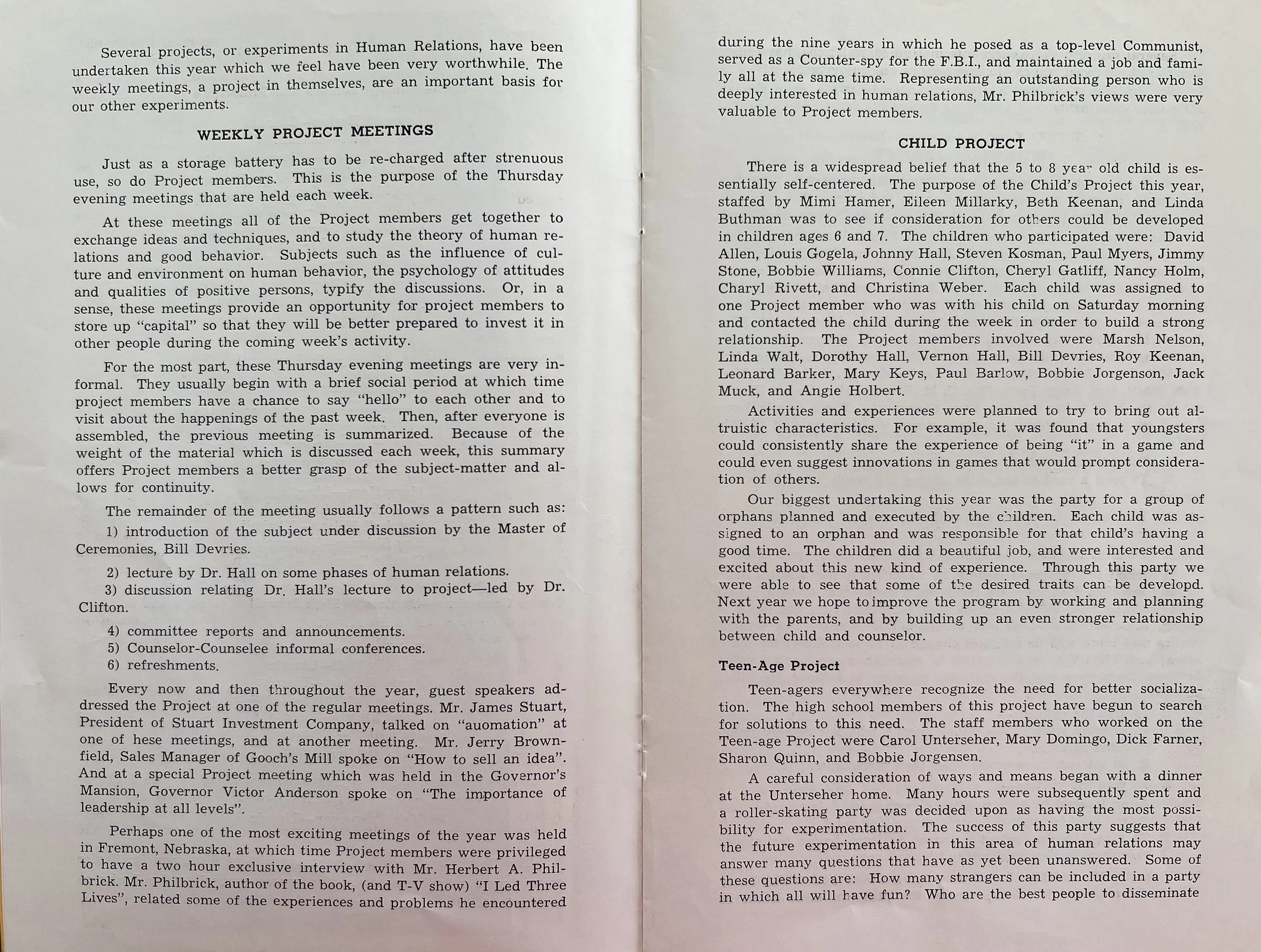Story 28 - Lincoln Citizenship Project
Extract from 1956 Brochure of NHRRF
In the fall of 1947, a study was made in the kindergarten of the Lincoln Public Schools. An effort to test whether youngsters would improve if their good behavior was constantly given recognition and if their bad behavior was not punished except when absolutely necessary. The success of this study could be measured not only in the improvement of the pupils but also in the enthusiasm which was developed among their parents.
Thus, another research project was designed to exploit this idea in a situation where the variables could be more carefully controlled. This required financial support beyond the amount that could be invested by the participants. Thus a group of three men, Mr. James Stuart, Mr. J. Lee Rankin, and Mr. Jerry Brownfield agreed to sponsor and finance the project.
Westminster Presbyterian Church generously provided the housing for the first year. The next two years, Teachers College, of the University of Nebraska took over the responsibility of providing housing. The past few years, the project has held its meetings in the University Student Union.
The first year, the project included two age groups for experimentation, a pre-school group and a junior high school group. The next year only the older group was studied. First, because it was thought that more could be learned if a smaller number were studied more thoroughly; and second, it was thought at that time the older group might be more likely to change if the evidence of success could be demonstrated to them.
The third year of experimentation a much larger budget was secured from Cooper Foundation by the men who originally sponsored the project. After two years of experience, Dean Henzlik of Teachers College proposed that the Positive Approach be tried with a larger group of people in a natural situation. Money was secured from Columbia Citizenship Project, financed by Carnegie Corporation.
In line with the Positive Approach, a six weeks period was spent in the attempt to secure a community which was superior in terms of community interest and development. Newman Grove, Nebraska, was selected. This community not only afforded an opportunity to study a good community, but was an excellent place to apply the principles and techniques learned in the Lincoln Project for new and worthwhile accomplishments. The purpose of this Newman Grove Project was essentially to try out the techniques of picking out individuals who were altruistic in behavior and have these leaders attempt to increase the community's capital in terms of better human relations.
During the past few years, the project has been studying the type of activities that are most appropriate to the development of human resource. The project has developed several techniques that have been significant to its success: personal contact, level of drive satisfaction, and multi-contact techniques.
Over the past years the Lincoln Project has been attempting to develop a technique of selecting university students with an interest in improving society and in turn having them become involved with developing interest and concern for others in an equal number of selected high school in an equal number of selected high school youngsters of high altruistic potential.
Outstanding results of the project have been that gifted campus students have been challenged to work with human relations problems. They have been challenged by the Positive Approach, and the results along these lines have been very positive. The project has worked with three age levels for the last few years: an upperclassmen college group, an underclassmen college group, and a high school group. A great deal has been learned about the kinds of skills and personal development necessary to be a good project member.
In 1954, five projects were undertaken by the Lincoln Citizenship Project: a family project, a child's project, an orthopedic project, a teen-age project, and a field trip to Chicago. During the year project members strived to learn how to effectively work with people, and personality development became a project of its own.
In 1955, the Lincoln Citizenship Project chose three major projects on which to concentrate their efforts: child's project, orthopedic project, and teen-age project. These three projects were chosen with the idea that the most positive results could be obtained by working with only three major projects.
In April of 1956, the Lincoln Citizenship Project was incorporated into a non-profit foundation. This foundation became known as the "Nebraska Human Resources Research Foundation."
1954-1955 Project Members
The Lincoln Project is an experiment dealing with the problems of human relations, how they can be coped with, and how they can be applied to daily living. The Positive Approach is a keynote to the experiment.
The Positive Approach involves these principles:
An understanding of the word good.
Giving recognition for good behavior.
Investing good in others.










